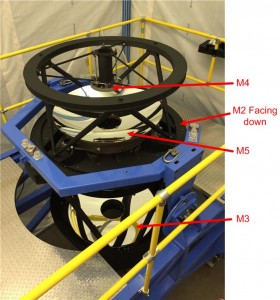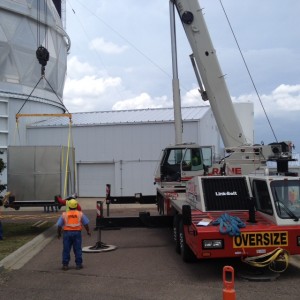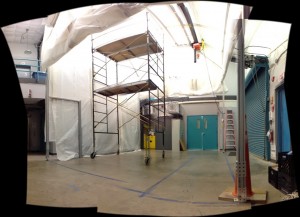This week the visiting engineers from Austin aligned the Video Alignment Telescope (VAT) to the corrector optics and then aligned the corrector to the the center of the primary mirror. This sets our axis for making all trajectories. We will now set the distance from the primary to the VAT. Work will continue over the weekend and we will then turn the VAT around and measure the angle from the VAT up to the CCAS instrument. This last will be night work. So far things are progressing on schedule.
Category Archives: WFU
The week of July 13
The big news this last week is that the Prime Focus Instrument Package (PFIP), the Lower Instrument Package (LIP) and Focal Plane Assembly (FPA) were installed. We are now in the process of getting electricity, glycol and air to these systems. We have started testing the subsystems in place such as filter wheels and guide probes. This is a bit tedious and sometimes requires careful book keeping as we bring together separate systems into one coherent telescope. This next week we hope to have the Austin WFU optics team come out to align the Corrector optics to both the PFIP mechanical system and the HET primary mirror optics. If that goes smoothly this next weekend we may be aligning the corrector to the CCAS tower optical system. All of these alignment tasks are accomplished with the Video Alignment Telescope (VAT) which is an auto-collimating camera which we have designed a mount that allows it to be mounted either pointed down towards the primary mirror or up towards the PFIP, FPA and CCAS tower and sky.
To get ready for this transition to more night work we have a 2nd telescope operator (TO) training with the TO who has been working with the engineers for the past 9 months. At the beginning of next month we will be ready for 1st light through the corrector and will start to require all 3 TOs and some of the Resident Astronomers to work all night long.
One very exciting test that we were able to conduct this past week was to actually test our oxygen sensors that have been installed to look for spills from the liquid nitrogen system which might displace some oxygen. This liquid nitrogen system has flow sensors that if it detects a spill will be able to shut down the flow fairly quickly but with a flow rate of 4 gallons per minute this could still be quite a few gallons spilled on the dome floor. We conducted a test using 40 gallons of liquid nitrogen in a large insulated dewar. Spilled in what we considered to be the most dangerous location (inside the pier of the telescope on the dome floor). The liquid nitrogen quickly turned to cold vapor upon hitting the floor and we found that only the first 1-2 inches reached critical values while oxygen values at 1 meter above the floor stayed above warning values for the entire test. The test reassured the operations staff that the oxygen sensors do work and the risks are minimal except in the most contrived and unrealistic scenarios.
The week of June 29
The big news for us this week is the lift of the wide field corrector to the top of the telescope. This involved removing the old test mass and the hexapods. The hexapods were serviced and put back on. The corrector was sealed up, rolled out of the clean tent into the dome floor and then lifted up to the top of the telescope. See the attached pictures.
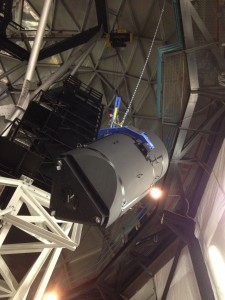
The lift of the Wide Field Corrector begins. The Corrector has its side plates mounted so no optics are visible.
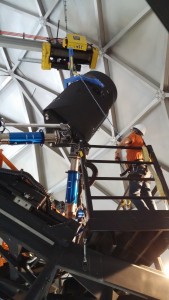
The corrector now at the top of the crane is lowered into the tracker. The blue and silver hexapods sticking up are only a small obstacle.
In addition the the installation of the corrector some work with the laster tracker was done and we determined the position of the base of the hexapods and see how much they may need to be shimmed to get into proper position for the corrector. At the same time we confirmed the distance to the CCAS instrument from the primary mirror and found it to be well within specifications for this corrector’s design focal distance.
Overall a great week with a major milestone passed. We now will start the PFIP installation as well as all of the plumbing and wiring connections to the new components.
The week of June 15
Not much to report this week as we prepare for the lift of the corrector. Since the corrector is going to have all of its covers on and it may be years until we actually have this view of it again I thought I would post this picture showing the 4 elements (M2 can not be seen as it is under M5. Note the reflections of the straight support members are severely bent showing the curvature of the mirrors.
The week of June 8
The WFU corrector has passed its initial tests in the clean room setup in the loading bay. This was done ahead of schedule and the corrector will be closed up and mounted on the tracker over the coming weeks. The worked involved people from Austin and the optics team and we are grateful for the long hours and careful work they did this week.
The HET Board Meeting was held on the previous week and the board was very impressed with the progress that had been made and the plans for the recommissioning. It was a great event and the board did not ask for any significant changes to the direction that the HET is going.
We continue to make progress in the testing and development of the telescope control system. We have conducted tests to implement new pointing zero points and are working on the tip and centroid tracker sphere. Having done these tests before the corrector is in place will give us a chance to look for potential problems and solutions before we even see first light.
At the end of this last week the test weight at the top of the telescope was removed and with it the CAT. This means we will have no more on-sky tests until the corrector is mounted and ready for commissioning.
The week of May 25
This was a big week for us. The Corrector optics and the Focal Plane Assembly arrives this week. Instead of the normal, mostly text blog, I thought I would just post a few pictures showing their arrival.
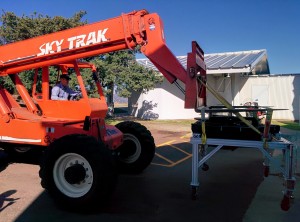
The Focal Plane Assembly, which will hold all of the guide probes and science fibers, arrives at the HET and is moved into the loading bay and then into the dome.
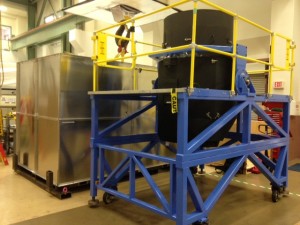
The Wide Field Corrector on its test stand in Arizona just before being loaded into the transport box.
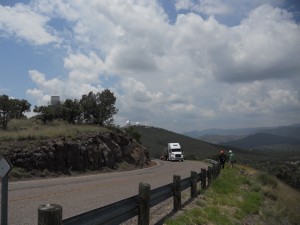
The WFC in the transport box coming slowly up the mountain. It had a police escort and traveled 45 mph all the way from Arizona!
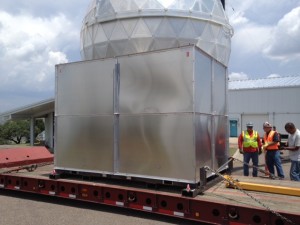
WFC arrives at the HET. We have to get it off the truck into the loading bay without exceeding the acceleration tolerances.
The week of May 11
Much of the work in the last couple of weeks has focussed on the imminent delivery of the wide field corrector from Arizona later this month. We will have to test that the optical alignment of the corrector survived the trip down HWY 10 by placing it in a make shift clean tent put together in the loading bay of the the HET. This tent has two HEPA air conditioning units and a dry nitrogen purge line to keep the optics clean. Although it takes up most of the loading bay we still have just enough room to squeeze around it to allow operations to continue. See the picture below.
Because of the slight delay mentioned in the previous blog post we have been looking at sub-systems which might cause further delays during the commissioning effort. This week we spent several days trying to increase the reliability of the communications in the CCAS tower and to shorten most copper cables and replace them with fiber where possible in advance of lightening season.
The night operations and software development teams continue to make progress on the Telescope Control System. Despite several weeks of delays due to poor weather we can now run trajectories on the sky with the tip-tilt camera and Distance Measuring Interferometer running to make refinements to the mount model of the telescope. We have also exercised the system with a few score of trajectories finding small bugs in the code well in advance of the bulk of the commissioning which will take place when the wide field corrector is mounted on the telescope in June.
In the last few weeks we have had an opening for a telescope operator. If you know of someone with a STEM (Science, Technology, Engineering and Math) background who would be excited by the idea of running one of the largest telescopes in the world and living in the the lovely Davis Mountains be sure to have them apply:
Positions open at McDonald Obs.
The week of April 20.
The big news from this week is that the review of the secondary corrector optics has completed. The review involved people internal and external to McDonald Observatory. The reviewers agreed with the WFU commissioning team that the corrector was ready to be shipped to the HET. However, they firmly suggested that the amount of knowledge transfer from University of Arizona to the maintenance team at the HET was not sufficient. Thus there will be a ~3 week delay in shipping the corrector so that the HET optical maintenance team can travel to University of Arizona and review the alignment procedures for future reference and in case of an unanticipated disaster in bringing the optics to the HET. This means that the corrector will not arrive in early May as planned but will arrive later in May.
The past three weeks have been dedicated to getting the telescope ready for various aspects of the upgrade. The mechanical and electrical teams have been trying to finish out various aspects of the VIRUS enclosures. The HRS has been stripped down to the optics table and the inside of the enclosure painted flat black.
The mirror team continues to pull the oldest mirrors in the array and replace them with freshly coated mirrors.
The night operations team continues to make sure that the alignment software is working well and is able to align all of the mirrors. Some tests of the telescope control system and mount models for the tracker motion have been tested. We now have pointing and tracking capability comparable to what we had before the upgrade began.
In the last few weeks one of our electrical technicians decided to retire. We have decided to change the position from a technician to an engineering position. If you know of an electrical engineer who is interested in living in West Texas be sure to have them apply:
Positions open at McDonald Obs.
The week of March 23
We did some simulations of data transfer rates in preparation for VIRUS coming on line. The data set consists of 900 fits files; each file is 8524800 bytes in size. The working assumption is that one Hetdex image consists of 150 spectrographs x 2 amplifiers/spectrograph x 3 dither per field with a CCD size of 1032×2064 pixels. Total data size is 7,672,320,000 bytes (7.3 GB). The data would be collected over 20 minutes (~6 minutes per dither) but it only took 449.5 seconds (7.5 minutes) to transfer this data to Austin. Thus we should be able to keep up with the data collection rate without bringing the network to a crawl.
The large air and glycol (“Blue Thunder”) hoses were installed through the Az wrap and laid in the trench in the floor and through one of the ports through the pier to the ring wall in the last two weeks. The next step will be to connect these to the outside lines and do a pressure test of the system.
All power connections for the VIRUS enclosures are now complete and tested. We have also conducted some heat load tests on the liquid nitrogen system by placing plastic bags over each of the VIRUS bayonets (the component that will stick into a VIRUS unit to keep it cold). So far most of the system checks out close to specification.
The primary mirror group installed 4 mirrors this week and continue to keep up their 30% over expected swap rate in hopes of being close to completion when the corrector is ready for commissioning.
The CCAS shutter failed this week and could not be repaired from inside the CCAS Dome. Instead of having to rent a very expensive 90 ft manlift the mechanical team found a way to safely undo the mounting to the CCAS Dome and lower it to the ground. A replacement shutter is on order and should arrive in the next week or two. It will be installed by just reversing the procedure developed to remove the old shutter. Until then we’ve installed a simple wood plug that can be removed manually (after climbing the 90ft tower) to continue with critical primary mirror work.
The week of March 9
The grating and guard rail around the liquid nitrogen tank have been completed. This gives the contractors safer access to the controls during our filling.
The air and glycol (“Blue Thunder”) hoses arrived and installation may start as early as next week. This will actually shut down the structure for a day or two as these are carefully integrated into the azimuth cable wrap below the telescope.
The HRS instrumentation team came out from Austin and disassembled the HRS and packed the optics up. Some of the optics will just be stored while the coated optics are being shipped out to be recoated for the HRS upgrade. The HRS enclosure has been cleared and once some preliminary electrical work is done the inside of the enclosure will be painted flat black.
Our telescope operator and video production guru has completed a new video showing the installation of the temporary clean room frame. See http://het.as.utexas.edu/wfu/ This clean room will house the corrector when it arrives in late April.
A visiting engineer from Texas A&M was back this week with the doors and sides for the VIRUS enclosure. A lot of work continues to seal, plumb and install electrical components in the enclosures and annex.
In night time commissioning we attempted a rewind test. This is to measure the time it takes from the abort of one 20 minute trajectory and rewind and start a 2nd trajectory. It took 79 seconds to make this transition which is a little longer than we really wish but still within the 80 seconds from abort to guider acquisition. We hope to shave 9 seconds off this time so that we can have 10 seconds to have the metrology and guiders acquire their stars.
The mirror team has been getting ahead of their minimum swap rate by swapping another 5 mirrors this last week. They hope to have all of the older mirrors swapped out by the time we start re-commissioning the telescope.

